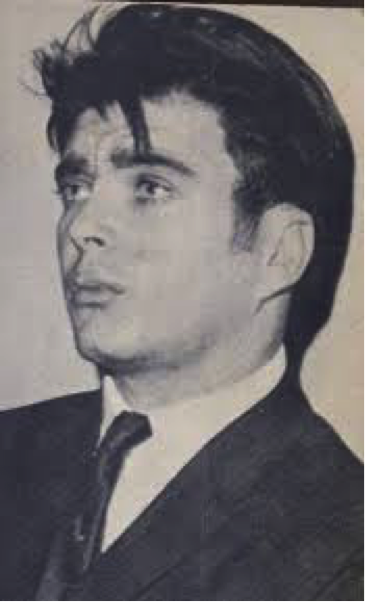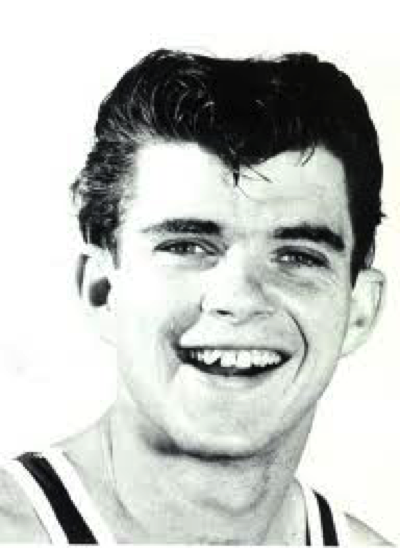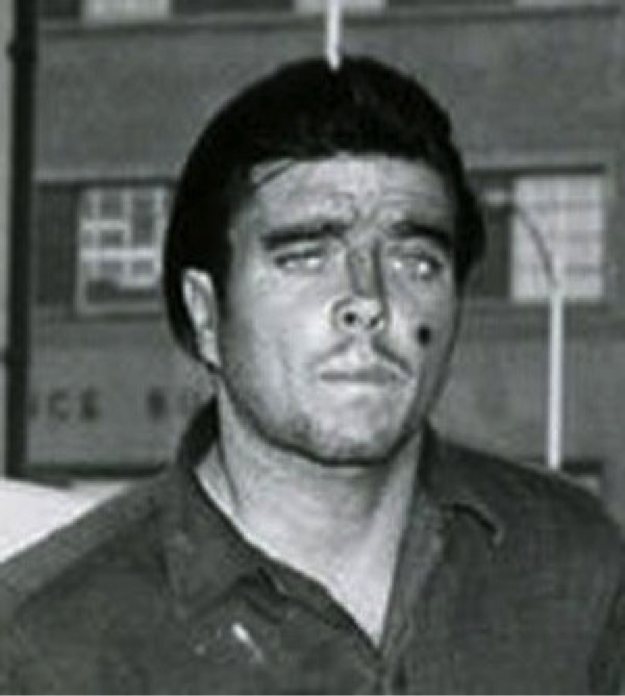Looking Into a Killer’s Eyes to Bring a Character to Life
By Guest | December 20, 2015 |
 Today’s guest is Emily Ross, whose debut novel, Half In Love With Death, released on December 16 (Merit Press). Before it was published, she received a 2014 Massachusetts Cultural Council finalist award for the manuscript. Her fiction and nonfiction have been published in Boston Magazine, Menda City Review and The Smoking Poet. A 2012 graduate of Grub Street’s Novel Incubator program, Emily is an editor and contributor at the writing blog Dead Darlings and works as a software developer by day. Welcome Emily!
Today’s guest is Emily Ross, whose debut novel, Half In Love With Death, released on December 16 (Merit Press). Before it was published, she received a 2014 Massachusetts Cultural Council finalist award for the manuscript. Her fiction and nonfiction have been published in Boston Magazine, Menda City Review and The Smoking Poet. A 2012 graduate of Grub Street’s Novel Incubator program, Emily is an editor and contributor at the writing blog Dead Darlings and works as a software developer by day. Welcome Emily!
In the 1960s a man named Charles Schmid murdered three teenage girls and buried them in the Arizona desert. Later, his eerie story became the inspiration for, Tony, one of the main characters in my novel, Half in Love with Death. Though inspired by a serial killer, Tony is the love interest of Caroline, the book’s protagonist, and he had to come across as seductive and irresistible for this attraction to be credible.
But how could I, as a writer, accomplish this paradoxical task?
The answer I discovered was chilling: I needed fall in love with Tony. And to do that I needed to get closer to Charles Schmid.
I’d already meticulously researched Schmid’s life. Known as the Pied Piper of Tucson, he was a hero to many Arizona teens—especially girls, who followed him to parties in the desert and kept his terrible secrets. He was charismatic and handsome, but for the parents of Aileen Rowe, and Wendy and Gretchen Fritz, the teenage girls he murdered, he was a nightmare. Understandably, I didn’t feel any emotional connection to him—that is, until I discovered the photos.
With news stories about Schmid abounding, there were plenty to be found online. Looking at them was like peering through a window into a time long gone. Though a monster, Schmid was an incredibly photogenic murderer. Thanks to the photos, I was finally able see the seductive side of this dangerous man, and to understand the powerful feelings that caused teens to abandon common sense and follow him.
In one photo, Schmid looks like a rock star, with his pretty face, sad pale eyes, and dark tousled hair. He has that irresistible combination of dangerous and beautiful that teenage girls go wild for. Recognizing his allure helped me understand how to make Tony more seductive.
In another photo, taken when Schmid was a high school gymnast—long before he became the Pied Piper—he looks sweet and mischievous. Seeing Schmid’s athletic side in this photo made me feel sympathy for him, and wonder what happened to transform this seemingly typical teenage boy into a killer. This gave me ideas for my own character: to make Tony more sympathetic, I decided to make him a championship diver, and came up with a traumatic event involving water that occurred when he was a child.
Indeed, though the photos helped me better understand Schmid, as I continued studying them, it was my character Tony, and not Schmid, who emerged. He spoke to me. He began appearing in my dreams and lurking in my subconscious, daring me to know him in that way writers must know their characters in order to make them real.
What struck me most about the photos were Schmid’s mesmerizing blue eyes. Lighter than the rest of his face, even in black and white, they provided me with an epithet to use for Tony. The way Caroline sees Tony’s striking blue eyes reflects her feelings for him throughout the book. At first, when unequivocally dazzled by Tony, she thinks, “Blue wasn’t a strong enough word for his eyes. They were cerulean.” But later, perplexed by his behavior and trying to understand him, she says, “His eyes were like a big blue drink, two parts sadness, one part loneliness.”
Other photos helped me understand both Schmid’s and Tony’s dark sides. After the murders, for example, Schmid began to paint a black mole on his cheek, and kept making the mole larger and larger. He also affixed a fake bandage to his nose. Girls thought this made him look tough. Journalists wondered what these strange alterations really meant. I took them as a clue that Schmid was showing the world he was turning into a monster.
In Half in Love with Death, as Tony’s dark side emerges, his appearance changes too. But unlike Schmid, Tony doesn’t deliberately alter the way he looks. Rather, Caroline’s perception of him is what changes. As she struggles to reconcile her strong feelings for him with her rising doubts, in her eyes he goes from resembling a china doll, to seeming like a mime in a white mask, to looking like a tormented otherworldly being.
Tony is not Charles Schmid, and Half in Love with Death, though inspired by facts, is a work of fiction. Nevertheless, those photos of Schmid were exactly what I needed to make Tony real—however different his story turned out to be.
Have you ever used photos to help with character development? What have you learned? What are some things that you do to get closer to a character?













Absolutely! A picture is worth a thousand words…right?
I have developed my character chart to include pictures of each of my major characters. Because my writing style is about 50% seat of the pantster, the pictures come after my character concept, not before. Next to their pictures I keep general notes on the character’s background, tracking significant details after (not before) I write them. I use my chart as a quick reference to refresh my memory as my books are a series.
The addition of pictures has served me well. They are my visual models and I have gone back on occasion just to gaze at their faces, noting features and expressions that have not only kept me on track, but have been known to breathe new life into a flagging character.
I have also used pictures of settings as a source of inspiration, including an outlandish home and property I came across while looking at a real estate guide.
Pictures are just another tool I add to the blueprint of my novels.
My first novel, Monument Road, featured two fringy secondary characters and a young POV character whose father was a low-level criminal. The boy seemed to have outgrown his family troubles only to have charges of sexual abuse raised against him.
Sexual offender laws mandate registration of convicted offenders, including their addresses, a summary of the conviction and a current photograph. These are not typical mug shots of the recently arrested in jumpsuits. For some, they are portraits of older men still on the list for crimes committed decades before.
I used this online database, as this post suggests, to seek a visual connection that my help me find empathy with my characters’ situations.
I got far more than expect from my random search when I recognized one of the faces.
This man in his 80’s volunteered alongside me in a program that served homeless people. A quiet, reliable, fix anything type. Searching further, I discovered I knew another volunteer and perhaps ten of the homeless men served by the program.
Let’s just say it was a revelation to discover how I’d unknowingly developed some empathy for these people before knowing their full backgrounds.
Wow what a fantastic research technique. That online database sounds so fascinating, and sad and interesting that some people are on this database from things they did decades ago. And I agree finding a photo helps us to empathize and recognize the humanity in others, and to glimpse the person behind the label.
I create a Pinterest board for all of my WIPs and find pics of not only my characters but also coastlines, towns, buildings, cars, items related to jobs or hobbies and the like. Very helpful for sparking the imagination (and for providing links to research articles).
Something you suggested I do! I’ll get around to it…I swear
I love Pinterest and want to make better use of it for my writing.
Hi, Emily:
Nothing speaks more powerfully, more directly, or more poignantly to our hearts than a human face. Photographs can often touch us so deeply we’d be foolish not to use that impression as source materials for a character.
But as you discovered, that first impression is just a start, and can even be misleading. The same work we use for all our characters is still required, but the outset is often far more tangible and powerfully when we work from a photograph — or, dare I say it, a real human being.
And just as with pictures, our impressions of a real person never tell the whole story. Which is why character work often feels like work in progress — and should feel that way.
Good luck with Tony et al. Have a lovely holiday, and thanks for joining us here.
David, I totally agree about the power of the human face to speak us via photos or real life. And yes it is kind of mysterious how a first impression can morph into something else over time. I guess is speaks to our ultimate inability to entirely pin down a character. Perhaps the most we can hope for is a glimpse of truth.
Those photos hurt! He’s so likable and mischievous in that photo where he’s grinning and so troubled and troubling in the photo with the painted on mole.
I come up with some of my best characters through sketching. I’ll sit in a park or at a bus stop and sketch the faces of the people walking past, and while I sketch I make up stories about their lives. They become my characters. I think the best way to make your characters feel like real people is to draw inspiration from real people.